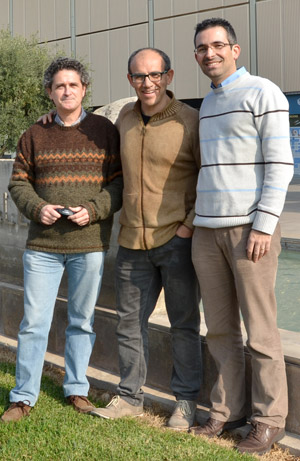Driving Styles
The UPV has developed a new version of the app to assess aggressive driving patterns in real time and report fuel consumption while driving
[ 10/05/2016 ]
Juan Carlos Cano and Carlos M. Tavares, researchers at the GRC-Networking Research Group of the Universitat Politècnica de València (UPV) have developed a new version of the Driving Styles app.
The app has now been downloaded over 5,000 times and has several functions, including a real-time warning of any pattern of aggressive driving, reporting both the total fuel consumption and CO2 levels emitted, and the money spent on a specific driving route. In addition, it provides warnings about which areas of the city cause most stress while driving.
Information is instantly sent to the user’s cell phone via bluetooth
With a bluetooth device, Driving Styles gathers information obtained from the vehicle's Electronic Control Unit -speed, fuel consumption, engine revolutions, acceleration, etc. It processes it and instantly sends it to the user's cell phone.
This system is connected to the car’s on-board diagnostic port OBD-II —which comes as a standard in all the vehicles made after 2000— and is linked to a smartphone via bluetooth. In addition, researchers have incorporated the use of heart rate bands and smart watches into the new version.
It calculates driving as a percentage and classifies it into three categories: calm, normal or aggressive
Driving Styles obtains data from the vehicle in real time and stores it every second in a trace, along with the current time and location in which the sample has been taken.
At the same time, the smartphone processes the data in a neural network in order to analyze the driving pattern. A percentage is calculated from that pattern, and based on that, it is classified as one of three possible categories: calm, normal or aggressive. "If a dangerous pattern is detected behind the wheel", the designers explain, "the users receive a warning about their way of driving and even an alarm on their cell phone or smart watch."
At the end of the route, the user can see and assess the statistics of the journey, as well as send the trace to the web server to store and analyze it.
Complemented with a website that provides individual and overall information
This app is complemented with a website in which every route is shown in detail, and provides an overall view of each driver. "The user can check the information about his or her routes and obtain detailed data, such as acceleration charts, speed and maps with the routes travelled. It also includes an individualized analysis of the driver's behavior behind the wheel, fuel consumption, etc.", Cano and Tavares explain.
In addition, the general database of all drivers provides information about driving styles in every country, doing comparisons as well as detecting the most stressful areas in every city for each driver.
"With this new version we wanted to go one step further. Our aim is to contribute to the safety of drivers, and at the same time, provide more efficient and economic driving, giving the user key information in real time," conclude the researchers at the GRC-Networking Research Group of the UPV.
e la UPV.
Noticias destacadas
 Acabar con la pobreza infantil en España aumentaría el PIB un 5'7%
Acabar con la pobreza infantil en España aumentaría el PIB un 5'7%
La pobreza infantil en España, a debate en unas jornadas organizadas por la Cátedra de Infancia y Adolescencia de la UPV, en Torrevieja
 QS rankings por materias
QS rankings por materias
La UPV, reconocida como mejor universidad de España para estudiar tanto Ingeniería Agroalimentaria y Forestal como Arte y Diseño
 La 'Escuela de Diseño' cambia de nombre
La 'Escuela de Diseño' cambia de nombre
La ETSIADI (Escuela Técnica Superior de Ingeniería Aeroespacial y Diseño Industrial) sustituye la denominación de ETSID
 La UPV, en la semifinal de Solo de Ciencia
La UPV, en la semifinal de Solo de Ciencia
Entre los diez semifinalistas, se encuentran Miguel López, investigador del CVBLab-Human Tech y Carolina Ropero, doctoranda en la UPV
 Primeros pasos del museo Ciència fallera de la UPV
Primeros pasos del museo Ciència fallera de la UPV
La UPV celebra el acto de entrega de premios del I concurso "La Ciència a les Falles". Los ninots ganadores, los primeros de este nuevo museo de la universidad
 UPV-CLÍNIC
UPV-CLÍNIC
La UPV e INCLIVA firman un convenio para impulsar conjuntamente la innovación en el ámbito de la salud







